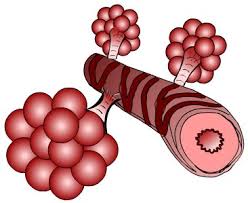 Come degree of bronchomotor tone resulting from tonic cholinergic parasympathetic activity is present in all normal individuals. Asthma is distinguished from the normal bronchoconstrictor response by the suddenness and severity with which bronchomotor tone increases. Life-threatening bron-choconstriction can occur in minutes; asthmatic bronchospasm may also remit spontaneously, sometimes for many years between “attacks.”
Come degree of bronchomotor tone resulting from tonic cholinergic parasympathetic activity is present in all normal individuals. Asthma is distinguished from the normal bronchoconstrictor response by the suddenness and severity with which bronchomotor tone increases. Life-threatening bron-choconstriction can occur in minutes; asthmatic bronchospasm may also remit spontaneously, sometimes for many years between “attacks.”
The etiology of asthma is diverse. Table 1 outlines some of the factors which may contribute to asthmatic bronchoconstriction. Some asthmatic events are iatrogenic; drugs causing betablockade exacerbate asthma. Drugs which inhibit the enzyme, prostaglandin synthetase, may cause severe asthma in some patients. All patients who develop bronchospasm after beta-blockade have pre-existing asthma; however, only a small fraction of asthma patients develop bronchospasm from prostaglandin synthetase-inhibiting drugs. Cholinesterase inhibitors slow the degradation of acetylcholine at the neuromuscular junction and potentiate cholinergically-mediated airway smooth muscle tone. This can lead to significant bronchoconstriction in patients with asthma. The mechanism of ethanol-induced bronchoconstriction is undefined but is not always related to the vehicle in which alcohol is ingested.
The role of psychologic events on bronchomotor tone in humans has been documented. Unfortunately, this has led to the erroneous belief among some patients that the origin of their asthma, rather than exacerbation, is psychologic. 
Postexercise-induced asthma has been widely studied. Although the pathogenesis remains incompletely defined, recent investigations have shown an important role for respiratory heat exchange in this form of asthma. Several factors may promote heat loss from the respiratory system. These include ambient temperature (cold air), degree of humidi-fication of inspired air, and ventilatory frequency. Hyperventilation during exercise promotes respiratory heat loss and causes bronchoconstriction. Exercise-induced asthma is blocked by disodium cromoglycate; this suggests that mast cell secretion of mediator may result from respiratory heat loss in this form of asthma.
The roles of mediator release, autonomic imbalance, and viral infections are considered subsequently in detail. The extreme variability in etio-logic factors suggest that asthma is a syndrome rather than a single disease where airway smooth muscle contraction is the final common pathway. Regardless of the initial stimulus, the final result is a three-component response consisting of: (1) increased airway smooth muscle tone, (2) mucous hypersecretion, and (3) regional inflammation of airways. The sequence of these events may be variable, and one may provoke the other. Viral inflammation may trigger reflex bronchoconstriction and mucous hypersecretion, or mediator release may precipitate airway inflammation with subsequent bronchoconstriction and mucous hypersecretion.
Table 1—Some Factors Contributing to Bronchoconstriction in Asthma
| Mediator release (allergic) |
| Histamine SRS-A Others Autonomic imbalance (neurophysiologic) |
| Irritant receptor response (parasympathetic) Altered adrenergic responsiveness (sympathetic) Nonspecific irritants Mediator-autonomic interactionsInfections (viral) |
| Pharmacologic (iatrogenic) |
| /^-Adrenergic blockadeProstaglandin inhibitors (aspirin, indomethacin, ibuprofren, etc.)Alcohol Anticholinesterase drugs Psychologic |
| Exercise (postexercise-induced asthma) |

